Galleries
Antony Gormley on Why His Art Makes Sense in New York
The artist's "Big Beamer" sculptures are on view at Sean Kelly.

The artist's "Big Beamer" sculptures are on view at Sean Kelly.

Sarah Cascone

In his current exhibition at New York’s Sean Kelly Gallery, Antony Gormley is going big. The show’s main features five mammoth expansions of his “Big Beamer” series, which depicts the human body in almost pixelated form using interlocking steel beams.
Downstairs, a new series, “Stretched Blockworks,” goes even bigger, the two rusted forms with their burnished patina weighing in at over 7,500 and 6,000 pounds—an impressive feat of transatlantic transportation and art installation if nothing else. The monumental works, which made the journey wrapped in wet muslin, to help age the surface, are almost architectural, recalling classic New York skyscrapers.
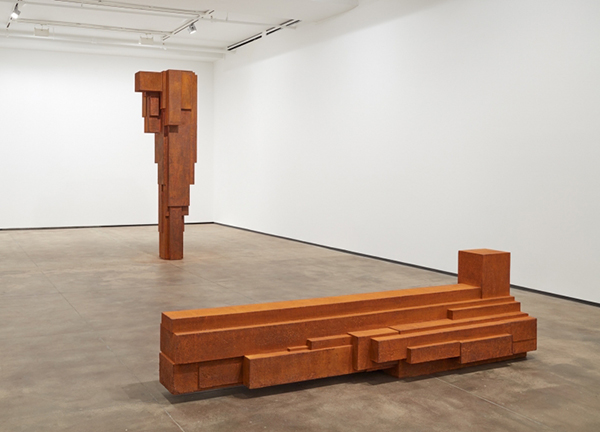
Installation view of “Antony Gormley: CONSTRUCT” at Sean Kelly, New York. Courtesy of photographer Jason Wyche and Sean Kelly, New York.
When artnet News met with Gormley, he was putting the finishing touches on the exhibition with a much smaller, quieter work. The British artist was creating a new version of a drawing called Compass, because the “original was too big for the gallery space. So I’m having to make it again.”
“I’m hoping I’m coming up with just two lines, one vertical, one horizontal, scratched into the surface of the wet paper that will just act as an introduction, a kind of statement of the central premise of the show,” said Gormley. That premise, in his own words, is that one can “objectively map the place of human life.”
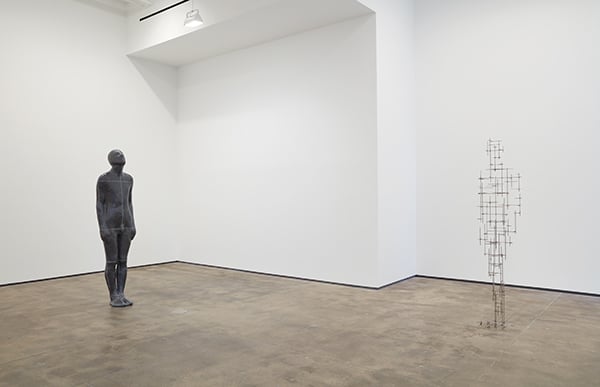
Installation view of “Antony Gormley: CONSTRUCT” at Sean Kelly, New York, with Bridge and Scaffold. Courtesy of photographer Jason Wyche and Sean Kelly, New York.
To that end, Gormley has paired that drawing with one of his earliest works, 1985’s Bridge, a mold of the artist’s body that is bisected by four lines that the artist likens to longitude and latitude lines on a globe, and Scaffold, a 2015 work that turns the body’s internal volume into a grid-like profusion of thin, stainless steel bar.
Gormley’s longstanding use of his own body in his work has deep intellectual underpinnings, and it seems unlikely that the casual fan truly understands his intention—something the artist readily admits. Gormley explained he began making casts of his body because “it’s the one bit of the material world that I have to live inside.” The resulting works, however, “are not visual objects. They are displacement of space,” and are significant for the empty void inside the case, not the mold itself.
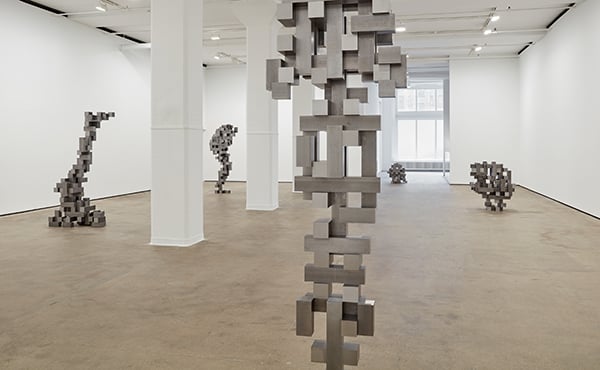
Installation view of “Antony Gormley: CONSTRUCT” at Sean Kelly, New York, with works from the “Big Beamer” series. Courtesy of photographer Jason Wyche and Sean Kelly, New York.
Throughout the history of Western art, artists have been “putting the body to work in a dramatic way that has everything to do with anatomy to the relationship of bone to muscle to skin, making that believable, making it expressive in order to reinforce mythological and historic narratives,” Gormley added. “I’m absolutely not interested in that.”
But he also doesn’t want to follow in the footsteps of the modernists, who “rejected the body as being irrelevant to the central premises of art.” Gormley’s practice, therefore, is about “bringing the body back as a place rather than an object… not as the ground of idealization or narrative, but as the location of being,” with works that function as “a sounding board for our own condition.”
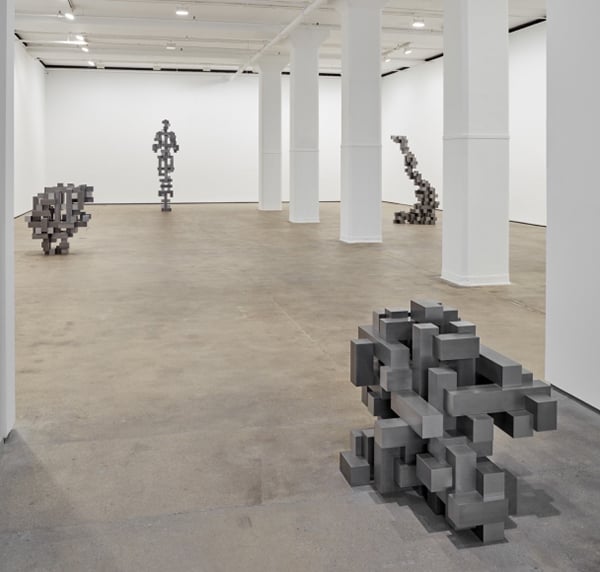
Installation view of “Antony Gormley: CONSTRUCT” at Sean Kelly, New York, with works from the “Big Beamer” series. Courtesy of photographer Jason Wyche and Sean Kelly, New York.
He understands that this point of view can be challenging. “If I came to my work and I was expecting it to be like a statue or like a Jeff Koons, I think I would rightfully think it was not worthy of my attention,” Gormley admitted. “I’m not interested in twiddling cultural reference knobs… I’m not interested in spectacle. If that means people are not interested in what I do, I accept it.”
With his latest work, in its larger-than-life scale, Gormley has perhaps gotten even less accessible. When it came to one of the first pieces in the show, Big Hide from the “Big Beamer” series, he admitted that “it’s almost impossible to see, as it were, an image of it. You are aware of it as a heap of raw material and it’s only perhaps after you have engaged with the other works… that you maybe see it as a body.”
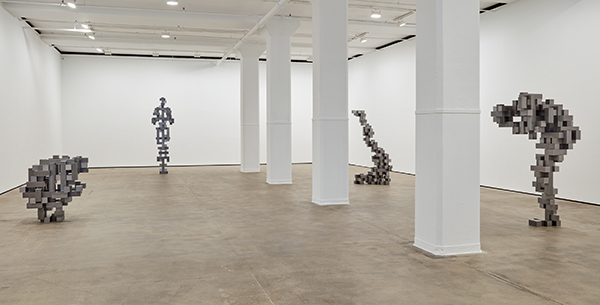
Installation view of “Antony Gormley: CONSTRUCT” at Sean Kelly, New York, with works from the “Big Beamer” series. Courtesy of photographer Jason Wyche and Sean Kelly, New York.
That doesn’t mean, however, that the sculpture is any less powerful—to him, or to the audience. “As the work has become more abstract, I would like to propose that it has also become more empathic, more capable of provoking and giving rise to feeling in the viewer,” Gormley said of the new pieces, which expand on his theme of orthogonal mapping, using densely-stacked, thick bars of steel.
“I could not think of a better place than Manhattan to show the ‘Beamer’ works,” the artist added. “There’s something very appropriate that the street grids here replicate the kind of grid that I have now used to map the space of the body.”
“Antony Gormley: CONSTRUCT” is on view at Sean Kelly, 475 Tenth Ave, New York, May 7–July 29, 2016.